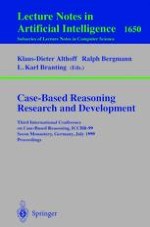The biennial International Conference on Case-Based Reasoning (ICCBR) - ries, which began in Sesimbra, Portugal, in 1995, was intended to provide an international forum for the best fundamental and applied research in case-based reasoning (CBR). It was hoped that such a forum would encourage the g- wth and rigor of the eld and overcome the previous tendency toward isolated national CBR communities. The foresight of the original ICCBR organizers has been rewarded by the growth of a vigorous and cosmopolitan CBR community. CBR is now widely recognized as a powerful and important computational technique for a wide range of practical applications. By promoting an exchange of ideas among CBR researchers from across the globe, the ICCBR series has facilitated the broader acceptance and use of CBR. ICCBR-99 has continued this tradition by attracting high-quality research and applications papers from around the world. Researchers from 21 countries submitted 80 papers to ICCBR-99. From these submissions, 17 papers were selected for long oral presentation, 7 were accepted for short oral presentation, and 19 papers were accepted as posters. This volume sets forth these 43 papers, which contain both mature work and innovative new ideas.
